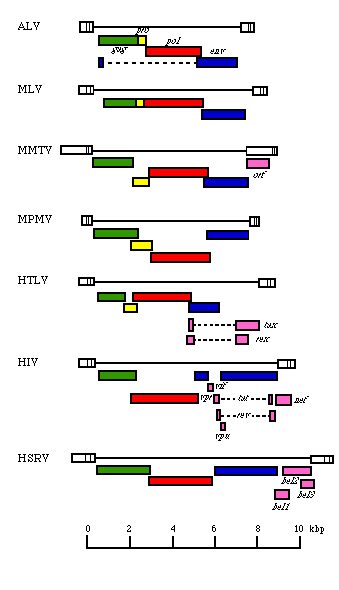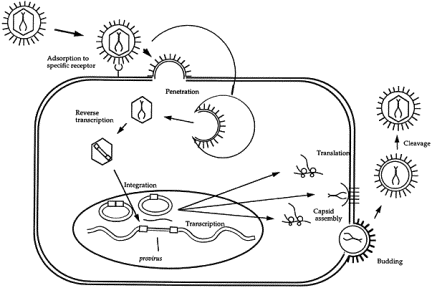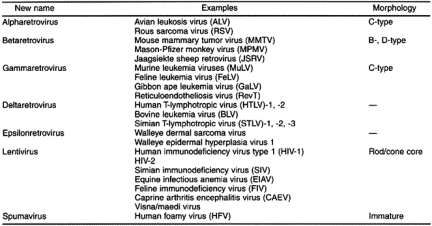
| |
| Basic Biology |
| Human Retroviruses |
| Human Immunodeficiency Virus (HIV) |
| Contact Us References |
| Introduction |
Retroviruses have only become a common part of popular consciousness in the past decade or two with the relatively recent emergence of HIV, but their history extends much farther. 1904: Ellerman and Bang search for an infectious agent for leukemia assuming it is a bacterium. They study a form of leukemia in chickens and are successful in transferring it from one chicken to another by cell free tissue filtrates. 1911: Solid tumors of chickens are transmitted by transplanting tissue by Peyton Rous. In so doing RSV is isolated as the infectious agent. This led to subsequent discoveries of other acute transforming retroviruses and much about their structure. 1960’s: It is known that retroviruses use RNA as their nucleic acid. Howard Temin combined this knowledge with observations that replication was inhibited by actinomycin D which inhibits DNA synthesis. He then proposed the notion of reverse transcription as the means of retrovirus replication. He shared the Nobel Prize with Baltimore in 1975. 1970’s: Richard Nixon starts “war on cancer.” It fails to find any retroviruses that cause cancer, but does forward biomedical research in the field. 1981: Human T-cell leukemia virus is discovered. It is the first pathogenic human retrovirus. 1983: HIV is discovered.
The Basic Biology of Retroviridae
The family Retroviridae consists of a large variety of viruses found in all forms of vertebrates. This family of enveloped RNA viruses includes some of the most influential viruses on human populations such as leukemia viruses. In fact, it is a retrovirus, the Human Immunodeficiency Virus (HIV) that is behind the worldwide Acquired Immunodeficiency Syndrome (AIDS) pandemic and is thus responsible for millions of deaths worldwide and countless suffering. 
Their unique life cycle and replication mechanism are what set them distinctly apart from other viruses. The virion contains RNA, but when it enters the host cell, the RNA is reverse transcribed into DNA using reverse transcriptase. This DNA is then actually integrated into the host DNA to form a provirus. This then serves as a template for transcription of viral RNAs and their resulting proteins which assemble into new virions. This reverse flow of information from RNA to DNA is a direct violation of the Central Dogma of Biology and is a key defining feature of the Retroviridae family. Integration of the viral DNA to form the provirus allows retroviruses to maintain infection in a host despite any immune response.
Virus Replication 1). Receptor binding and membrane fusion (Field’s Virology)
Classification
Human Retroviruses Human T-Cell lymphotropic Virus Types I and II HTLV I and II is included in the retroviridae family because of its nucleotide sequence and genome structure. Morphologically they are named the primate T-cell leukemia/lymphoma viruses. They are biologically distinct from the human immunodeficiency viruses in the lentivirus genus. Clinical manifestations of HTLV-I are linked with the development of adult T-cell leukemia/lymphoma and a progressive neurological disease called HTLV-I associated myelopathy. HTLV-II is also linked with leukemia and neurologic disease cases as well. Human Immunodeficiency viruses Human immunodeficiency viruses are part of the lentivirus genus. It includes the disease subtypes HIV-1 and HIV-2, the third and fourth human retroviruses discovered. HIV enters the host cell through the CD4 molecule and chemokine receptor as a dual receptor system. The biology of HIV-1 has been highly researched due to the pressing concerns of an HIV global pandemic and push for vaccine and treatment development. See Link Human Immunodeficiency Virus.
Contact Us
Lauren Gong gong@stanford.edu
Chad Ishmael cishmael@gmail.com
References: Microbiology at Leicester. School of Biological Sciences, University of Leicester. Last Update: June 13, 2005. < http://www-micro.msb.le.ac.uk/3035/Retroviruses.html>. Knipe, David M. et al. Fields Virology. Fourth Edition Lippincot Williams& Wilkins. June 2001. [Field's online edition]. Mandell, Gerald L. et al. Principles and Practice of Infectious Disease. Sixth Edition Churchill Livingstone. October 22, 2004. pp. 1874. |
Links to other web resources on retroviridae See previous Humans and Viruses webpages |

